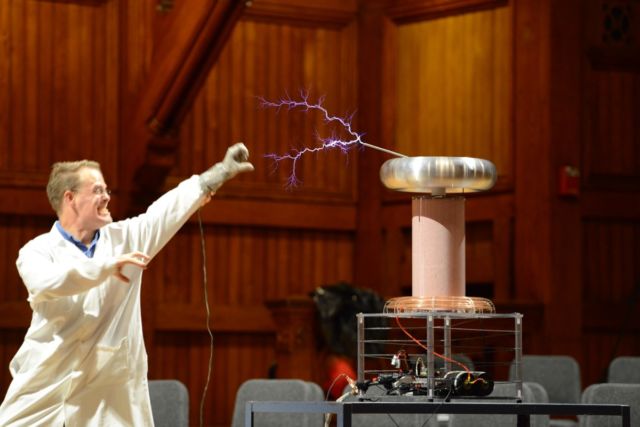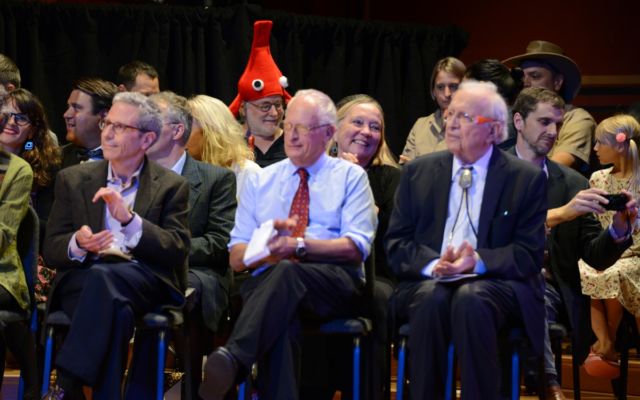
Ever wondered why so many people don't read instruction manuals, or how many calories are in the human body? Or whether stabbing a voodoo doll representing your horrible boss with pins could help reduce workplace tension? The winners of this year's Ig Nobel Prizes have got you covered. These and other unusual research topics were honored tonight in a ceremony at Harvard University's Sanders Theater.
Established in 1991, the Ig Nobels are a good-natured parody of the Nobel Prizes, honoring "achievements that first make people laugh, and then make them think." The prizes have always been perceived as a celebration of scientific silliness, an impression strengthened by the unapologetically campy awards ceremony. The festivities feature mini-operas, scientific demos, and the 24/7 lectures, whereby experts must explain their work twice: once in 24 seconds, and the second in just seven words. Acceptance speeches are limited to 60 seconds, strictly enforced by an eight-year-old girl nicknamed "Miss Sweetie-Poo," who will interrupt those who exceed the time limit by repeating, "Please stop. I'm bored." Until they stop.
"The research being honored might seem ridiculous, but that doesn't mean it is devoid of scientific merit."
It's all in good dorky fun. But there's also a serious side to the Ig Nobels. The research being honored might seem ridiculous at first glance, but that doesn't mean it is devoid of scientific merit. Take the 2006 Ig Nobel for physics, awarded to French researchers for investigating why dry spaghetti often breaks into more than two pieces when it is bent. That work led to a new bendy paintbrush in Adobe Illustrator 5. More importantly, studying how cracks form and spread in various kinds of materials is critical to detecting imminent failure in, say, bridge spans or human bones. Just last month MIT physicists published a follow-up paper. But more people are likely to read about breaking spaghetti than peruse an academic paper entitled "Controlling fracture cascades through twisting and quenching."
Founder Marc Abrahams admits that when he first created the Ig Nobel Prizes and the associated Journal of Irreproducible Results, he struggled to come up with a pithy slogan that captured the full intent of the venture. He settled on science "that cannot or should not be reproduced," but in his mind it always only told half the story. It wasn't until chatting with a reporter many years later that he hit upon the current slogan.
The reporter in question relished the chance to mock what he perceived to be frivolous and therefore useless science, citing a married couple who invented a special kind of underwear containing a charcoal filter, the better to trap gases from, well, farts. Abrahams pointed out that the wife in that couple suffered from Crohn's disease, a severe inflammation of the bowel that affects 1.6 million people in the US alone. One of the side effects is particularly odiferous gassy emissions; the underwear was a way to make her quality of life just a little bit better.
One of my favorite papers in 2015 was by a pair of Berkeley physicists who noticed an oddity while absent-mindedly spinning their wedding rings over coffee one day. They determined a wedding ring spins more like a boomerang than a coin because of the hole in the center. The work has that silly Ig Nobel element. But it could also one day help improve the design of hydrofoils, speed boats, or racing cars, for example, to achieve a better balance between the dueling forces of friction and aerodynamics as they zip across a surface.
Even when there is no immediate usefulness, there's still a strong argument to be made on the basis of pure curiosity. Scientists have naturally inquisitive minds, and it's good to encourage the occasional random line of inquiry. At least one Ig Nobel recipient, Andre Geim, has gone on to win a bona fide Nobel Prize, albeit for a different line of research.

It is in this spirit of curiosity and sense of play that we offer you the 2018 Ig Nobel Prize winners.
Medicine
Laugh: Marc Mitchell and David Wartinger, for using roller coaster rides to hasten the passage of kidney stones.
Think: Kidney stones account for around 300,000 emergency room visits each year, and patients usually just wait for the stones to pass, which can be a long and painful process. The recipients heard enough anecdotal reports of people passing stones more easily while bungee jumping or riding roller coasters (like the Big Thunder Mountain Railroad ride at Walt Disney World) that they deemed it worth investigating further. If you've ever had kidney stones, you'll value knowing that a rear seating position on a roller coaster is a good way to pass them more quickly.
Anthropology
Laugh: Tomas Persson, Gabriela-Alina Sauciuc, and Elaine Madsen, for collecting evidence, in a zoo, that chimpanzees imitate humans about as often, and about as well, as humans imitate chimpanzees.
Think: Imitation is the sincerest form of flattery. It's also crucial to human development, particularly when it comes to social bonds and the transfer of skills and knowledge. It has been assumed that chimpanzees and other non-human primates did not engage in imitation games. This study looking at interactions between chimpanzees and visitors to the zoo suggests that might not be the case. The chimpanzees proved to be more like humans in engaging in imitation games than previously believed.
Biology
Laugh: Paul Becher, Sebastien Lebreton, Erika Wallin, Erik Hedenstrom, Felipe Borrero-Echeverry, Marie Bengtsson, Volker Jorger, and Peter Witzgall, for demonstrating that wine experts can reliably identify, by smell, the presence of a single fly in a glass of wine.
Think: Female fruit flies emit a pheromone with a strong unpleasant scent easily detected by humans, which makes them a great way to tell male and female fruit flies apart. The researchers were able to identify the specific pheromone, so powerful a single female fly could spoil a glass of wine. After all, fruit flies love fruity things, like diving into that glass of wine you're trying to savor. Thanks to science, if a fly lands in your wine, you'll know immediately from the "off" smell and taste if it was a female fly. You can mourn her passing along with the loss of an excellent vintage.
Chemistry
Laugh: Paula Romao, Adilia Alarcao, and the late Cesar Viana, for measuring the degree to which human saliva is a good cleaning agent for dirty surfaces.
Think: Admit it, you've been known to occasionally use a bit of saliva to rub off a smudge now and then. Conservationists prefer their own saliva when cleaning delicate surfaces, like gold leaf or painted ceramics. The authors' experiment showed that intuition is good science: saliva cleans gilded surfaces in particular better than other cleaners used by conservationists. They even identified the likely component responsible, bringing us one step closer to producing a synthetic version of saliva for cleaning.
Medical education
Laugh: Akira Horiuchi, for the medical report, "Colonoscopy in the Sitting Position: Lessons Learned from Self-Colonoscopy."
Think: Colonoscopies are never pleasant, but some people have more difficulty with them than others. There's a long tradition of scientists using themselves as guinea pigs—in this case, to explore whether it might be better to conduct a colonoscopy while in a seated versus the usual supine position. That's just what the recipient did, not just once, but four different times, with varying degrees of discomfort. So even single patients' experiences can vary. He called for further study comparing seated and supine positions to determine whether the former might be better for problem patients.
Literature
Laugh: Thea Blackler, Rafael Gomez, Vesna Popovic, and M. Helen Thompson, for documenting that most people who use complicated products do not read the instruction manual.
Think: The people who design our consumer products (cell phones, DVD players, and so forth) often complain that customers just don't read the manual, and thus never make full use of all the amazing advanced features. The customers in turn feel overwhelmed by "feature bloat" and don't find those manuals especially useful, often preferring to figure things out on their own by tinkering. As the recipients put it in their paper, "Life's too short to RTFM." Understanding who does and does not RTFM could help companies design better manuals in the future—which, let's face it, most of us still won't read.
Nutrition
Laugh: James Cole, for calculating that the caloric intake from a human-cannibalism diet is significantly lower than the caloric intake from most other traditional meat diets.
Think: Why would anyone want to calculate the nutritional value of the human body, apart from members of the Donner Party? Someone who's interested in studying the rare cases of cannibalism throughout history, that's who—not just in modern humans but also in fossil remains from the Paleolithic era. Turns out the human body is not particularly high in nutritional value, especially when compared to other kinds of meat. This suggests that there were primarily social and cultural reasons people resorted to cannibalism.
Peace
Laugh: Francisco Alonso, Cristina Esteban, Andrea Serge, Maria-Luisa Ballestar, Jaime Sanmartin, Constanza Calatayud, and Beatriz Alamar, for measuring the frequency, motivation, and effects of shouting and cursing while driving an automobile.
Think: Most of us are inclined to mutter a bit of profanity when stuck in traffic, but roughly one-quarter of us are particularly aggressive when it comes to shouting and cursing at other drivers (especially, it seems, in Spain). The recipients studied the frequency of this behavior and possible stress factors behind it, as well as the impact on traffic safety. Most people view such behavior as relatively harmless, when in fact, that level of aggression is associated with a higher rate of accidents (a major cause of death and injury worldwide).
Reproductive medicine
Laugh: John Barry, Bruce Blank, and Michel Boileau, for using postage stamps to test whether the male sexual organ is functioning properly—as described in their study, "Nocturnal Penile Tumescence Monitoring with Stamps."
Think: Impotence is embarrassing, to be sure, but it can also be a symptom for more serious conditions (diabetes, lymphoma, or arteriosclerosis, for instance). One way to tell the difference between impotence that's "psychogenic" and impotence that has an underlying physical cause is whether or not the patient gets erections while sleeping. Sure, you can hook your member up to a strain gauge recorder at night or ask your sexual partner to track your nighttime erections. But it's so much easier to wrap the "stamp ring" (similar in size to Christmas seals) around it at night and just check to see if the stamp ring broke along the perforations overnight because of an erection.
Economics
Laugh: Lindie Hanyu Liang, Douglas Brown, Huiwen Lian, Samuel Hanig, D. Lance Ferris, and Lisa Keeping, for investigating whether it is effective for employees to use Voodoo dolls to retaliate against abusive bosses.
Think: Even the recipients admit in their paper that "it is difficult to offer direct practical implications from our study." But if you have a supervisor who routinely subjects you to public ridicule, scapegoating, or other abusive behavior, chances are you'll eventually retaliate as a knee-jerk attempt to restore a sense of justice. That usually escalates the situation and could end up adversely impacting the company's bottom line. Stabbing a voodoo doll representing your supervisor with pins can be cathartic. It's one kind of psychological tool to right the balance of feeling wronged, and it could spur discussion of other non-confrontational strategies to deal with this common workplace problem.
reader comments
78